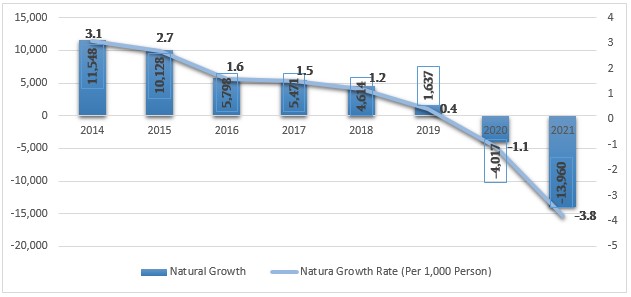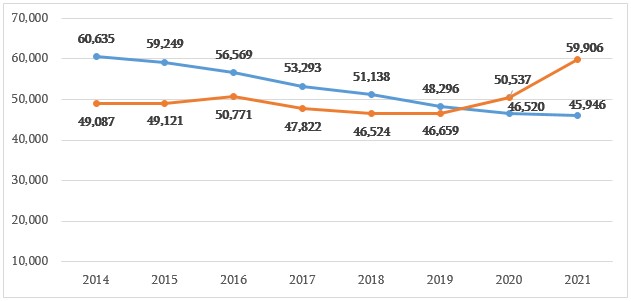Declining birth rates is the biggest challenge for Georgia as well as for most of developed countries. These demographic problems have been further exacerbated amid the pandemic.
Negative natural growth [1] was registered in Georgia in 2021. This means that number of deaths exceeded the number of births by 13,960. In every Georgian region, except for the Ajara Autonomous Republic, a negative natural growth was registered. The natural growth was also negative in 2020 whilst tis figure also increased further last year. In 2015-2019, Georgia had positive natural growth figures, although the natural growth rate has been declining annually.
Graph 1: Natural Growth Figures in 2014-2021 [2]

Source: National Statistics Office of Georgia
In 2021, there were 45,946 babies born in Georgia which is 1.2% less as compared to the previous year. Georgia’s birth rate (number of live births) has been declining annually in 2015-2021. The previous years’ statistics show that the number of first and second children in the birth rate shrinks whilst the share of third and additional children is increased.
The government seeks to deal with the negative birth rate dynamic with financial incentives. In particular, all Georgian nationals have their childbirth expenses reimbursed from 2013 (physiological birth by GEL 500 and caesarean birth by GEL 800). Since 2014, a new state programme has been launched to improve the demographic situation which envisions material incentives for giving birth. In those regions where there are no positive natural growth figures, a monthly allowance is disbursed for every third and next new-borns until the age of two years. In high mountainous regions, this allowance is GEL 200 and GEL 150 for people living elsewhere. These material incentives to promote childbirth cannot be assessed as efficient and, furthermore, this is an improper expense. This is proven by the fact that the birth rate has actually shrunk instead of increased since launching the government programme to offer material incentives to encourage childbirths.
In regard to the death rate, there were 59,906 deaths registered in Georgia in 2021. As compared to 2020, the number of deaths increased by 18.5%. Since 2016, there was a declining death trend, although the number of deaths sharply increased in 2020-2021 which is directly linked with the pandemic. In 2020, there were over 2,500 COVID-19 deaths in Georgia whilst the number of COVID-19 deaths reached 13,800 by the end of 2021.
Graph 2: Number of Live Births and Deaths

Source: National Statistics Office of Georgia
[1] The difference between births and deaths.
[2] The natural growth rate for 2021 is based on the author’s calculations.







